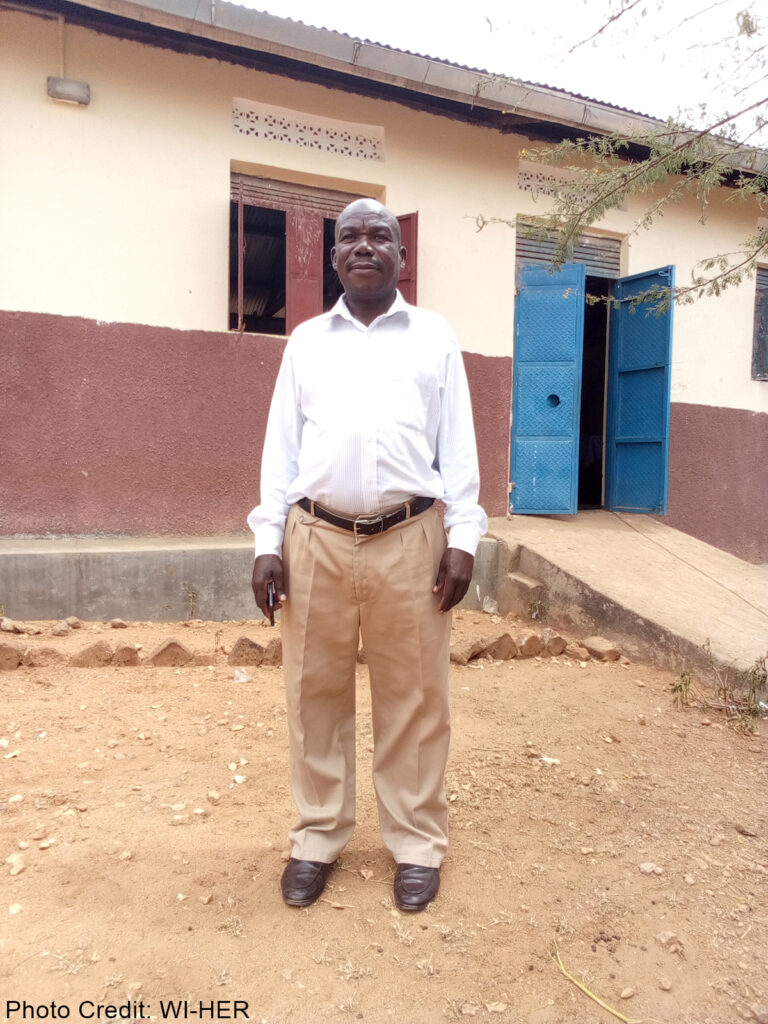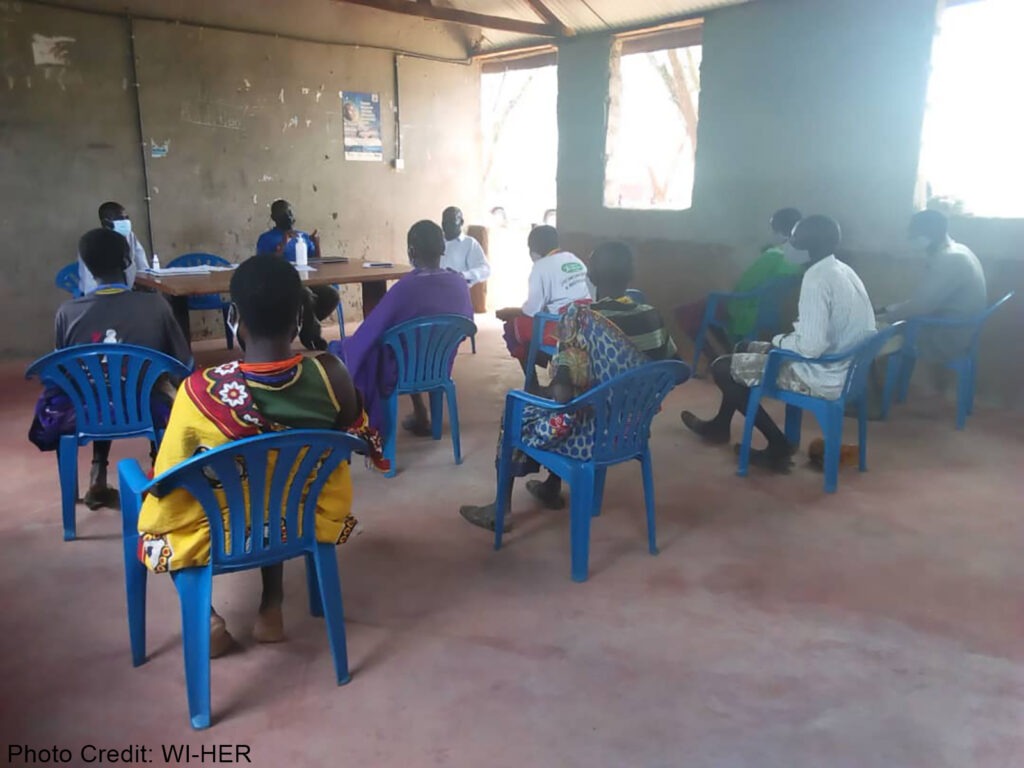From Zero to 100: How Integration of Gender Equity and Social Inclusion Helps Reach Ugandan Communities with NTD Treatment
By: Mike Mukirane Biregho, RTI Senior Health System Strengthening Advisor; Emmanuel Ssegawa, WI-HER Senior Gender & Youth Advisor; Claire Karlsson, WI-HER Senior Global Associate
Along the north-eastern border of Uganda, Moroto district sits in the Karamoja region, an area home to numerous nomadic pastoralist groups. Vincent Muron lives in Moroto with his family and serves as a senior ophthalmic clinical officer by trade, as well as an advocate for the health of his community.

“Moroto is inhabited by the Karamojong communities. These are cattle keepers, they are nomadic, they move from one place to another in search for water and pasture. That is their normal activity, they are pastoralists. Life here is quite hard because they depend mainly on animal products, that’s the milk. And the animal population has gone down, meaning the population is impoverished, they don’t have resources to be able to sustain their living. They depend now on cutting of firewood, burning charcoal, and selling those items for their survival,” Vincent said.
Across the country, Uganda has seen incredible success in reducing the burden of trachoma, a neglected tropical disease (NTD) and the world’s leading infectious cause of preventable blindness. However, Moroto’s health authorities have struggled to achieve the same success, in part because of the unique characteristics of Moroto – the people, their livelihoods, and their remote location along the Uganda – Kenya border.
The Ugandan Ministry of Health sought to ensure medicines for trachoma were available to all Ugandans in need, as well as to understand what populations were being missed and why. Therefore, they decided to conduct a gender equity and social inclusion (GESI) analysis with support from USAID’s Act to End Neglected Tropical Diseases East (Act |East) program, through RTI International and WI-HER. The analysis sought to understand what factors related to gender, disability, or social status might be hindering people from receiving NTD medicines. As part of this analysis, Moroto citizens joined focus groups to discuss their knowledge of NTDs, their access to treatment, the reasons they might not want to take the medicines, and how trachoma impacted their lives and their families. The results of the analysis indicated that gender and social inclusion barriers impacted exposure to infection, and influenced access to and uptake of NTD services, including during mass treatment campaigns in Moroto.
“Sometimes because of the gender roles, you find women most of the time are not home during the mass drug administration,” Vincent said. “They are not there to take the medicine. They are out there, to cut firewood, or to burn charcoal to earn a living. So you find they are not around during that time when we are doing mass drug administration, so they miss out.”
He continued, “Men provide security to their animals and to their family members. In the process of providing security to the animals they sometimes move out in search for pasture and water for the animals. And that makes sometimes the access to men as well quite challenging.”
Armed with richer insight into which populations were not being treated and why, the Ugandan government, with support from Act | East, began to prepare intensified efforts to reach these communities with treatment through a pilot behavior change activity. The Uganda Ministry of Health and Act | East formed a team of district local government staff from across sectors, including Vincent, and trained them on how to recognize barriers to treatment and how to encourage behavior change in their communities. By reviewing treatment data, the Moroto district team was able to identify four villages in Moroto where many people missed mass treatment the previous year and therefore were ideal places for a targeted behavior change activity. The Moroto district team also identified root agents, or health workers and community development staff selected to lead the behavior change activity in their communities. For each village, the root agents selected community members who had not taken the medicine in the latest NTD treatment campaign. The goal of the behavior change activity was for all 60 community members identified to receive treatment for trachoma in the next campaign.

The root agents worked closely with community members to identify barriers to treatment and to select key influencers such as local elders and religious leaders who could mobilize communities to accept treatment. With guidance from the root agents and Moroto district team, the key influencers created solutions to address barriers to treatment access and uptake. For example, the key influencers designed and tested ways to inform household members about treatment dates, particularly heads of households through house-to-house visits and phone calls. This solution was grounded in the knowledge that sometimes people miss information about treatment timing due to gender and social related norms regarding roles and responsibilities, as well as because of geographic barriers.
Vincent elaborates, “They don’t get the information that mass drug administration is due because sometimes some of these communities are far and they are not reached with the information. Sometimes we give the information through radio talks shows, sometimes though the public address system. But some areas may not be accessible, especially during the rainy season. You find some roads are not accessible because of the poor roads and at the time there are seasonal rivers that flow and cut off some of the places. So some areas are not reached.”
Leading up to the 2021 treatment campaign, the key influencers implemented a variety of solutions in their villages, targeting their efforts to community members selected for the behavior change activity. At the end of the treatment campaign, 100% of the 60 targeted community members took treatment for trachoma. The Moroto district team also found that the activity had impact far beyond those initially engaged: nearly all people in the villages accepted treatment during the campaign. “I mobilized children in the whole village to receive drugs,” said a 40-year-old community member from Loboborio Village, who took it upon himself to spread the message further than his household.
“We need to make sure that everybody – irrespective of who we are or whatever, we need equal access to these services. Without equal access, you find some people miss out, women, shepherds who go to kraals,” said Vincent.
Act | East continues to support the Ugandan Ministry of Health to ensure access to and uptake of trachoma treatment in Moroto and other communities still at risk for the disease. The success of the behavior change activity in Moroto has inspired the expansion of the work to additional villages and communities in Moroto and scaled up to two additional districts of Nabilatuk and Amudat where trachoma still persists. To ensure trachoma is eliminated in Uganda, it will take strong leadership at all levels, combined with support from champions like Vincent and other key community influencers to make a difference, individual by individual and village by village. Vincent plans on continuing to play a leadership role in Moroto to ensure more people are reached with treatment in the years to come and share what he knows with colleagues in other districts still struggling with NTDs.
“Once we are able to integrate GESI into the NTD programming, I have hope that we can achieve something much better than we have been doing,” said Vincent. From zero to 100, Act | East is continuing to support governments to increase equity and access to treatment, improving health in Moroto and beyond, toward a world free of NTDs.
Learn more about our work to eliminate neglected tropical diseases.